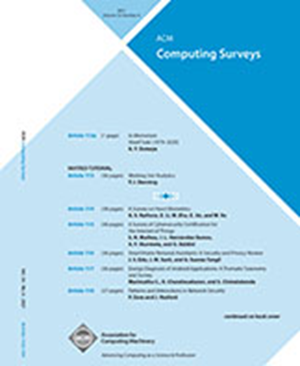Self-adaptive Federated Learning in Internet of Things Systems: A Review
IF 23.8
1区 计算机科学
Q1 COMPUTER SCIENCE, THEORY & METHODS
引用次数: 0
Abstract
In recent years, Federated Learning (FL) and the Internet of Things (IoT) have enabled numerous Artificial Intelligence (AI) applications. FL offers advantages over traditional Machine Learning (ML) and Deep Learning (DL) by shifting model training to the edge. However, the dynamic nature of IoT environments often interferes with FL’s ability to converge quickly and deliver consistent performance. Therefore, a self-adaptive approach is necessary to react to context changes and maintain system performance. This paper provides a systematic overview of current efforts to integrate self-adaptation in FL for IoT. We review key computing disciplines, including Self-Adaptive Systems (SAS), Feedback Controls, IoT, and FL. Additionally, we present (i) a multidimensional taxonomy to highlight the core characteristics of self-adaptive FL systems and (ii) a conceptual architecture for self-adaptive FL in IoT, applied to Anomaly Detection (AD) in smart homes. Finally, we discuss the motivations, implementations, applications, and challenges of self-adaptive FL systems in IoT contexts.物联网系统中的自适应联合学习:综述
近年来,联邦学习(FL)和物联网(IoT)为众多人工智能(AI)应用提供了可能。与传统的机器学习(ML)和深度学习(DL)相比,FL 具有将模型训练转移到边缘的优势。然而,物联网环境的动态特性往往会影响 FL 快速收敛和提供一致性能的能力。因此,有必要采用自适应方法来应对环境变化并保持系统性能。本文系统地概述了当前将自适应集成到物联网 FL 中的努力。我们回顾了关键计算学科,包括自适应系统(SAS)、反馈控制、物联网和 FL。此外,我们还介绍了 (i) 多维分类法,以突出自适应 FL 系统的核心特征;(ii) 物联网中自适应 FL 的概念架构,并将其应用于智能家居中的异常检测 (AD)。最后,我们讨论了物联网背景下自适应 FL 系统的动机、实施、应用和挑战。
本文章由计算机程序翻译,如有差异,请以英文原文为准。
求助全文
约1分钟内获得全文
求助全文
来源期刊

ACM Computing Surveys
工程技术-计算机:理论方法
CiteScore
33.20
自引率
0.60%
发文量
372
审稿时长
12 months
期刊介绍:
ACM Computing Surveys is an academic journal that focuses on publishing surveys and tutorials on various areas of computing research and practice. The journal aims to provide comprehensive and easily understandable articles that guide readers through the literature and help them understand topics outside their specialties. In terms of impact, CSUR has a high reputation with a 2022 Impact Factor of 16.6. It is ranked 3rd out of 111 journals in the field of Computer Science Theory & Methods.
ACM Computing Surveys is indexed and abstracted in various services, including AI2 Semantic Scholar, Baidu, Clarivate/ISI: JCR, CNKI, DeepDyve, DTU, EBSCO: EDS/HOST, and IET Inspec, among others.
 求助内容:
求助内容: 应助结果提醒方式:
应助结果提醒方式:


